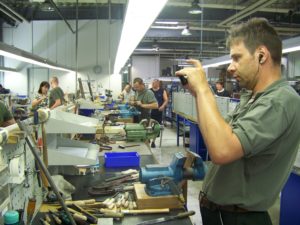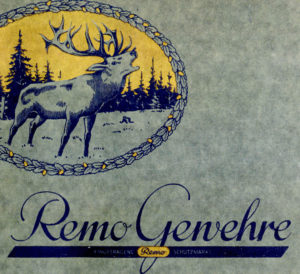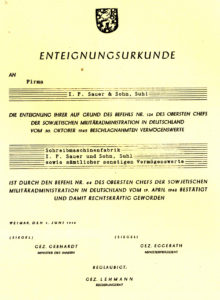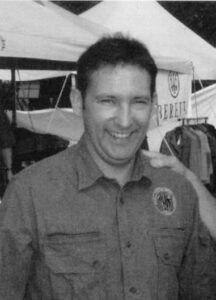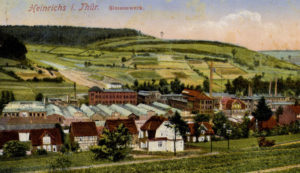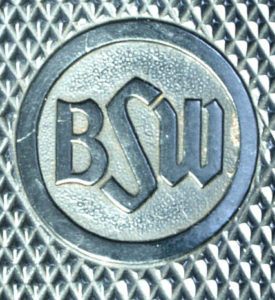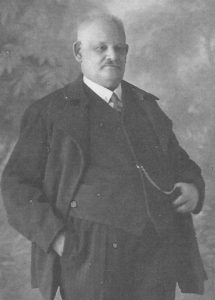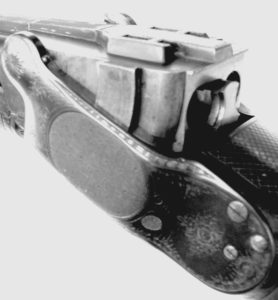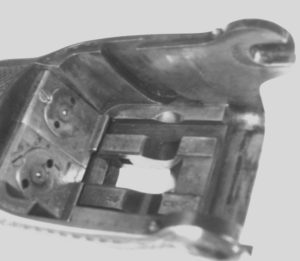Gun Manufacturers – Gun Makers and Engravers
Gun Dealers and Gun Shops
both former and today’s in alphabetical order.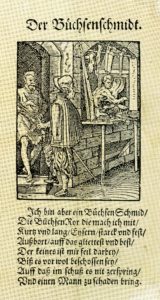
Former Gun Manufacturers, Gun Makers and Engravers, Gun Dealers and Gun Shops
that made or sold German Hunting Guns
| It is not easy to decide when a gun maker becomes a gun manufacturer. Most of the bigger gun manufacturers had their beginning as small shops with a few gunsmiths and stock makers that bought raw components from factories and had work done by other shops that specialized in certain work. It is also difficult to be sure of who actually made a gun, because the name on the gun might be that of the dealer who sold the gun and either bought or ordered it from a gun maker.
Most gun dealers had their own gun shops mostly for doing repairs, but bigger ones also finished partly finished guns that were purchased from other gun makers in Germany, Belgium and other countries and even England. The major manufacturers had their own engraving departments that also trained new engravers. Some of the more experienced engravers had their own shops next to or in their homes and did the more elaborate engravings for the factories. Unfortunately, not even the master engravers who did the most elaborate engravings were allowed to sign their work, and identifying the engraver on an older gun is very difficult if not impossible. It must also be mentioned that most of the older German hunting guns had some engraving, even on the least expensive models. |
Today’s Gun Makers, Engravers and Dealers of German Hunting Guns
Most of the traditional bolt-action rifles and combination guns are still made today, but the following changes and trends are apparent:
Prices of German factory made guns are in general higher than equal models in the United States but usually offer more custom features. Guns made to order by some factories and the smaller makers are as a rule quite expensive, but not nearly as pricey as best English guns.
Bolt Action Rifles made in the bigger factories have mostly switched to designs that have the bolt lock directly into the breech end of the barrel, a design that was patented by Louis Schlegelmilch at the Spandau Arsenal in 1889. This design makes it possible to quickly install a barrel in a different caliber, on some without the use of any tools. These rifles are also very suitable as takedown rifles that today’s world traveler appreciates.
Very fine custom-built bolt-action rifles are available from various smaller makers that cater to all wishes a customer might have. Most use Mauser 98 type actions, but declining numbers of military surplus actions. Instead, they tend to choose reproduction Mauser actions with custom features like square bridge receivers, hinged floor plates, three position side-swing safeties and a great variety of scope mounts, including the German claw mounts. They are made for the lightest to the very heaviest big bore calibers.
New safeties and triggers for bolt action rifles are designed for greater reliability, where wing safeties are locked in the safe position and single set-triggers un-cock themselves when the bolt is opened. One of the latest designs has a separate cocking mechanism built into the bolt that allows the rifle to be carried in an un-cocked condition and cocked quickly when ready to shoot.
Drillings and Combination Guns are still available in the various barrel configurations of the older German guns. However, there is considerable improvement in strength of the actions and barrels through the use of modern steels, allowing heavy magnum calibers. Old and proven strong locking devices that were very expensive in the good old times have been re-discovered and can be produced more economically on modern computer-controlled machining centers.
A big bore African caliber can now be combined with a 3”-20 Ga, shotgun barrel, giving the dangerous game hunter an additional shot with a rifled slug that has stopping power. Many of the trigger mechanisms are now much safer because of the separate cocking features. Another major improvement are floating rifle barrels.
The owners of traditional, older guns know that the impact of the rifle bullet will climb as the rifle barrel on a soldered barrel assembly gets hot. A floating rifle barrel on modern Drillings prevents this. A built in regulating mechanism at the muzzle of a double rifle Drilling makes regulation and re-regulation a whole lot easier and will not require rebluing of the barrels. It must be said, however, that the appearance of some modern Drillings when compared to the old timers has suffered, but beauty is in the eye of the beholder.
Vierlings are still made but are hard on your pocket book. They usually give you an additional small caliber rifle barrel that is located in the top rib or between the shotgun barrels. The lock mechanism is much more complicated, weight must be a consideration and the use of an aluminum receiver might be advisable, except for very heavy calibers.
Double rifles are offered by the Blaser, the Heym and the Krieghoff Companies and by the few remaining small makers in Suhl. Better steel, stronger locking mechanisms, barrel regulation devices and separate cocking mechanisms make these guns very practical and reliable for the big game hunter. The Ziegenhahn Company in Zella-Mehlis can build a fine box lock or side lock double rifle that compares very favorably with the best made in the world.
Traditional German over and under shotguns are still made in the traditional way by the Merkel company and by a few small makers in Suhl, using the Kersten locking mechanism and minor improvements.
Max Ern makes over and under guns with a unique rising bite bolting system.
The Krieghoff K-80 over and under shotgun, developed and improved from the Remington Model 32, has captured a great following for use in the field, for skeet, trap and sporting clays. The Krieghoff Company also offers a custom round action side lock shotgun in various calibers that found instant acclaim.
Merkel makes a wide selection of traditional side-by-side and over and under shotguns, both as box lock or side lock guns in various grades, models and calibers.
When it comes to Air Rifles, German-made rifles win most medals in international competition, including the Olympics. Hartmann & Weiss and Schilling make single shot rifles on falling block actions.
| Abesser & Merkel, formerly in Suhl
Adamy in Suhl Adolph, Fred formerly in USA AKAH – Kind in Hunstig, Germany Ansorg, formerly in Zella-Mehlis Barella, formerly in Berlin-Germany Bartels, formerly in Zella-Mehlis Behr, Burkard & Behr’s Waffen-Werke of Bremen & Suhl Bock, Otto- Berlin Brenneke Guns and Ammunition BÜHAG, Bühag (Buehag) Cooperative in Suhl Daly, Charles in New York Dreyse, Nicholaus von Dreyse and sons Ern, Max in Leverkusen,-Germany Eyring in Suhl Förster –W. Foerster in Berlin Frühauf, Hendrik in Breitenbach near Suhl Funk, formerly in Suhl Greifelt in Suhl Gründig, Carl in Dresden Hagn, Martin in Cranbrook-Canada Hartmann & Weiss in Hamburg-Germany Heym, Friedrich Wilhelm in Suhl, Münnerstadt, Gleichamberg Jaeger, Franz formerly in Suhl
|
Jaeger, Kurt formerly in Suhl and Mainz
Jaeger, Paul formerly in Jenkintown, Pa. Kersten, Gustav in Strassburg Kettners, Eduard & Franz Kind in Hunstig, Germany Krieghoff, in Germany and USA Kuchenreuter, A Gunmaking Dynasty Lindner, H.A. in Suhl Meffert, Imman. in Suhl Merkel, Bernhard in Suhl Merkel, Ernst August in Suhl Merkel, Oskar in Suhl Merkel, Paul Ernst in Suhl Merkel Brothers (Gebrüder Merkel) in Suhl Oberhammer, Peter of Munich Prechtl in Birkenau-Germany Rasch, George L. & Christof W. in Braunschweig Reeb, J.J. Reeb Company in Bonn Rempt, formerly in Suhl Sauer, J.P. & Co. formerly in Suhl Sauer, J.P. in Eckernförde and Isny Scherping, Heinrich- Hannover Schilling in Zella-Mehlis Schiwy, Ludwig in Berlin Simson Suhl-BSW-WAFFA-Gustloff Werke Stendebach, C.F. in Germany Stiegele, formerly in München, Germany Steigleder, Ernst of Berlin & suhl Thieme & Schlegelmilch, formerly in Suhl Willig in Schweinfurt, Germany Ziegenhahn, formerly in Suhl, now in Zella-Mehlis |
In the alphabetical list that follows we combine the listings of German Breech Loading Hunting Gun Makers and Dealers, both former ones as well as those still in business today. This list will eventually be very long, especially the one about former Gun Makers. We will concentrate our efforts on those makers and dealers where good information is available.
To find a dealer or gun maker by first name or company name, scroll down through the alphabetical listings.
To open additional information, articles and photos in our archive about a certain maker or dealer, click on Archive.
Stop back to see new listings that will be added as quickly as we can and as new information becomes available. Additions and corrections are welcome. We do not have the time to answer many inquiries and suggest that you first patiently try to find answers in this website.
Scroll Down on Alphabetical List of Gun Makers – Manufacturers – Dealers
P to T
Prechtl, Gottfried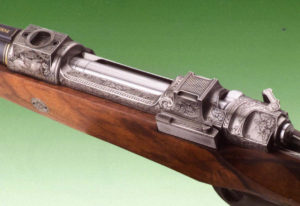
Jagd- und Sportwaffen
Auf der Aue 3
D – 69488 BirkenauGermany
Telefon +49 6201 167 88
E-Mail: info@prechtl-waffen.de
Web: www.prechtl-waffen.deThe company builds best quality bolt action hunting rifles on their own Double Square Bridge Mauser 98 Actions and also makes actions, gun components and production machines for gun makers.For a feature article about Prechtl that originally appeared in GGCA Journal #41, see our Archive.
Rasch, George Ludwig & Christof Werner of Braunschwig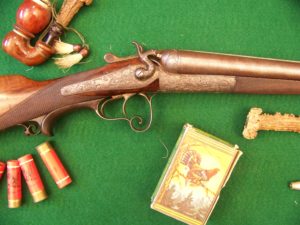
The Rasch family of Gun Makers goes back hundreds of years and is still being carried on today by Ernst Rasch’s son in law- 82 year old Otto Ebert. The full story of the extensive Rasch family can be found at The Rasch family of Braunschwieg.
Reeb
J.J. Reeb Company in BonnJohann Jakob Reeb (1843-1924) Gunsmith, worked for Ewald Becher in 1867 and took over the business in 1872, 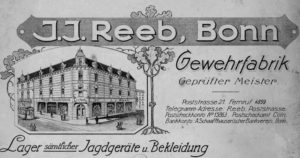 opened a shop in 1877 and turned over thje business in 1809 to his sons Philip and Hans. The company name was now “J.J.Reeb Jr.”Hans Reeb Jr. Gunmaker, became a master in 1911 and took over the business from his father, together with his brother Hans Reeb.
opened a shop in 1877 and turned over thje business in 1809 to his sons Philip and Hans. The company name was now “J.J.Reeb Jr.”Hans Reeb Jr. Gunmaker, became a master in 1911 and took over the business from his father, together with his brother Hans Reeb.
All the Reebs, besides being master gunsmiths had shops besides thriving retail businesses that catered to the wealthy in the nobility and aristocracy. They were listed as suppliers to the courts of “Prinz Leopold of Prussia – Kronprinz of the German Reich of Prussia – Prinz Chlodwig of Hessen – Herzog Carl Eduard” This fact is confirmed by the many Reeb guns that are highly engraved and embellished.
Although records show that a separate shop was acquired for Hans Reeb, a master gun maker they can’t have had the ability to make most of the many guns we have seen. Markings on some guns show that they were made in Liege–Belgium. Others are marked with the names of Suhl gun makers or can be identifies as guns made in Suhl, and the names of the gun makers. That the Stobbe andC.F.Triebel name were found on two Reeb guns are proof of this.
can’t have had the ability to make most of the many guns we have seen. Markings on some guns show that they were made in Liege–Belgium. Others are marked with the names of Suhl gun makers or can be identifies as guns made in Suhl, and the names of the gun makers. That the Stobbe andC.F.Triebel name were found on two Reeb guns are proof of this.
They might have bought machine parts made in Suhl or Liege thet needed for guns made in their shop. For this they had to have an actioner, a stock maker and possible an in house engraver and had to have the capability to do all the finishing work.
All the Reeb guns we have seen are very attractive and you can see
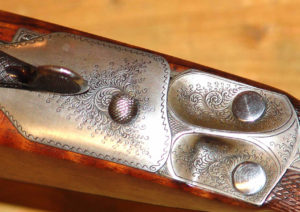 photos of some of them in our Archive (Nr. 58-PG).
photos of some of them in our Archive (Nr. 58-PG).
Articles about Reeb guns, including the summary of one that appeared in Deutsches Waffen Journal about a gun by Reeb with a very unusual firing mechanism, are also in our Archive (117-T).
The company was established in 1865 and remained in business through the end of World War II in 1945 under Walter Rempt.
They patented quite a few inventions that were used in their guns. Their catalog lists several over and under shotgun models, one of them with trunnions on both sides of the lower barrel and a very low profile.
They also offered various side-by-side double barrel shotgun models, over and under combination guns and Drillings, as well as over and under and side by side double barrel shotguns and stalking rifles.
They built bolt action sporting rifles on the Mauser 98 action and on a bolt action of their own design.
They also offered inexpensive single barrel shotguns and a two shot bolt action shotgun.
You will find articles about a very special gun made for a special occasion, one of their over and under shotguns and the advertising of their bolt action rifles in our Archive.
The re-print of a REMO catalog is available from sales@germanguns.com
J.P. SAUER & SOHN in SUHL
Located in the mountains and valleys of Thuringia the “Green Heart of Germany” is found the “Waffenstadt Suhl” that was formerly one of the most important gun making centers of Germany.1751 Established by Lorenz Sauer (Principal firm).
The first Sauer Company was founded in 1751 by Lorenz Sauer and was the oldest recorded manufacturer of firearms in all of 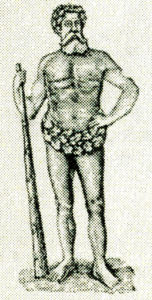 Germany. In 1815 Johann-Gottlob Sauer started managing the firm, and in 1835 Johann Paul Sauer became the manager. It was in 1840 that Johann Paul Sauer and his son, Lorenz created the new name, J.P.Sauer & Sohn and utilized a trademark with this name. A complete timeline is in our Archive.
Germany. In 1815 Johann-Gottlob Sauer started managing the firm, and in 1835 Johann Paul Sauer became the manager. It was in 1840 that Johann Paul Sauer and his son, Lorenz created the new name, J.P.Sauer & Sohn and utilized a trademark with this name. A complete timeline is in our Archive.
It was a true family business that passed from one Sauer generation to the next. In 1811 it became the first firearms company in Suhl to produce weapons for the German military. The original company ceased to exist at the end of World War II. Sauer was a leader in the production of sporting and hunting weapons, as well as pistols and military rifles.
The original company produced many different types of hunting guns, from single barrel rifles, side by side double rifles, over and under double rifles, shotgun / rifle combination guns, side by side shotguns, over and under shotguns and Drillings (Three barrel guns mostly with two shotgun barrels and one rifle barrel).This company produced guns of the highest quality and used the very best material. It was second to none in the entire world!
To read the complete history of the company and descriptions of their guns, go to the Archive.
Scherping, Heinrich of Hannover
Royal Court Gunmaker, Heinrich Scherping, Hannover, whom we will introduce to our readers today is well known to gun experts and hunters. Now at the age of 77 he started his business in June of 1857 in Hannover and became very successful. He celebrated his 50th Anniversary last June and was honored by many admirers with a presentation of a certificate medallion. May the Se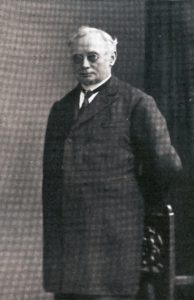 nior Meister enjoy many more years in his field of expertise. Tranlated from the 1908 issue of Schuss und Waffe by George Brinkop. Go to the Archive- Scherping, Heinrich for more.
nior Meister enjoy many more years in his field of expertise. Tranlated from the 1908 issue of Schuss und Waffe by George Brinkop. Go to the Archive- Scherping, Heinrich for more.
Custom Gunmaker
Schilling Color Case Hardening
Peter-Haseney-Strasse 32
D-98544 Zella-Mehlis
Germany
Phone: 0049-3682-40448
Fax: 0049-3682-486706
schilling@schilling-beschichtungen.de
www.schilling-beschichtungen.de
www.alfred-schilling.de
The Schilling family in Zella-Mehlis dates back to 1648 and all of 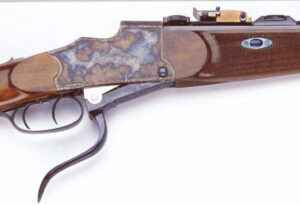 them made their living in the production of goods made from iron and steel, just like most of the men in Zella-Mehlis, among whom is included Walther and his well known pistols, Anschuetz and many others. At the end of World War II, American troops came to Zella-Mehlis first, but three months later Russian troops took over and all of Thuringia ended up behind the Iron Curtain. Gradually, all companies closed their doors, and today there are only two gun makers left in Zella-Mehlis. One of them is the Ziegenhahn Company that moved from Suhl to Zella-Mehlis. The other is the Schilling Company. Jörg Schilling re-founded the company in 1998 after he had finished his college education at the University in Jena. By this time the two parts of Germany had been re-united, and you will find two interesting articles to this effect in our Archive.
them made their living in the production of goods made from iron and steel, just like most of the men in Zella-Mehlis, among whom is included Walther and his well known pistols, Anschuetz and many others. At the end of World War II, American troops came to Zella-Mehlis first, but three months later Russian troops took over and all of Thuringia ended up behind the Iron Curtain. Gradually, all companies closed their doors, and today there are only two gun makers left in Zella-Mehlis. One of them is the Ziegenhahn Company that moved from Suhl to Zella-Mehlis. The other is the Schilling Company. Jörg Schilling re-founded the company in 1998 after he had finished his college education at the University in Jena. By this time the two parts of Germany had been re-united, and you will find two interesting articles to this effect in our Archive.
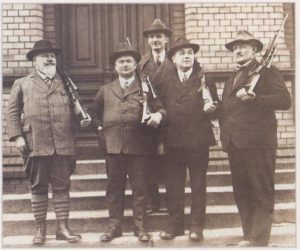
Schiwy, Ludwig- Berlin
He is known to have been in business in 1925 but undoubtedly started long before that. He was still active after 1945 when his only customers would have been occupation forces. He is best known for specializing in high quality and high grade arms for high ranking Nazi’s the most noted being Reichsjaegermeister Hermann Göring. Ludwig was the favorite or “go to” gunsmith of Göring. Schiwy’s addresses in Berlin were SW 68, Lindenstraße 90, Kochstraße 59 in 1941 and Bendlerstraße 11-14 after 1945. He had four patents, three were for improvements to the Luger handgun and the fourth was DRP 599722 issued on Nov. 18, 1932 for a special rear sight for rifles used in shooting at running game such as wild boar. Click Here to go to the Archive page to read more.
New names and new owners:
BSW – WAFFA – Gustloff Werke
Maker of Hunting and Military Guns, Bicycles, Motorcycles, Automobiles, etc.
The Simson Company was not only the biggest company in Suhl but also the most versatile one. Besides hunting guns the company made military guns, automobiles, motorcycles, bicycles and more. Where most gun makers depended on other companies for the supply of material and gun related services, Simson was able to do all this in their own factories. All their products were of best quality.
versatile one. Besides hunting guns the company made military guns, automobiles, motorcycles, bicycles and more. Where most gun makers depended on other companies for the supply of material and gun related services, Simson was able to do all this in their own factories. All their products were of best quality.
The known history of Suhl dates back to 1437 when an iron hammer work and the first “Feuergewehre”(fire guns) were recorded. Gun making had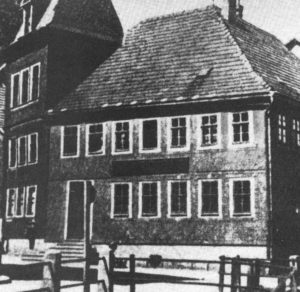 come to Suhl because iron ore was found in the mountains and water power and wood were available to smelt the iron and water power could be used to drive the hammer works that turned the iron into steel. This in turn attracted gun makers to settle in Suhl. As iron ore was found in other parts of the country that were more accessible, the mining of iron ore and the need for hammer works came to an end. The Simsons took adventage of this and bought several such hammer works very reasonably, one in the location where their factory emerged and became the biggest one far and wide. The Simsons, a Jewish family, were first mentioned when the brothers Löb and Moses Simsonbought one of the steel hammer works in Heinrichs, a district on the outskirt of Suhl.
come to Suhl because iron ore was found in the mountains and water power and wood were available to smelt the iron and water power could be used to drive the hammer works that turned the iron into steel. This in turn attracted gun makers to settle in Suhl. As iron ore was found in other parts of the country that were more accessible, the mining of iron ore and the need for hammer works came to an end. The Simsons took adventage of this and bought several such hammer works very reasonably, one in the location where their factory emerged and became the biggest one far and wide. The Simsons, a Jewish family, were first mentioned when the brothers Löb and Moses Simsonbought one of the steel hammer works in Heinrichs, a district on the outskirt of Suhl.
In April of 1856 the Simson Works were founded with the name “Gebrüder Simson,”but Löb Simson passed away in 1886. The company expanded rapidly, especially when the “Werra-Bahn” railroad link was opened in 1859. The company started to produce Bajonets, Ramrods and Gun Barrels in 1862.
In 1863 a partnership between Moses Simson and Karl Luck, a mechanic and specialist, the “Gewehrfabrik Simson & Luck” was founded. The company produced complete military rifles and delivered 15000 Model 71 rifles by 1872. Moses Simson passed away in 1868 and the company was first run by Luise Simson, assisted by her sons Moses and Gerson.
In 1880 the first hunting guns were made at Simson & Luck. A new railroad link  to Erfurt that included one of the longest tunnels built at the time. This further enhanced the prospects for theSuhl gun makers. Karl Luck left the company in1884, and in 1889 the legal name of the company was now “Simson & Co.”. The company received substantial military orders for the Model 88.
to Erfurt that included one of the longest tunnels built at the time. This further enhanced the prospects for theSuhl gun makers. Karl Luck left the company in1884, and in 1889 the legal name of the company was now “Simson & Co.”. The company received substantial military orders for the Model 88.
In 1896 the production of bicycles with balloon tires began and became a major part of the Simson success story for many years to come.
The same year a company office in Berlin was staffed with Max Simson, Arthur Simson as the technical director and Julius Simson, a lawyer. This enhanced their standing in the world and gave them a better chance to receive government orders.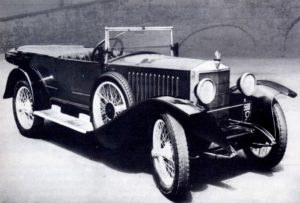
At this time the first catalog of modern hunting guns came out also. Being good businessmen, the Simsons realized that gun making had its up and downs, prospering when military guns were in demand but facing very hard times when wars ended.
Hunting and sporting guns could not fill the gap alone, and bicycles,
motorcycles, baby carriages and automobiles were also produced by the Simson factory. Like quite a few gun makers all over the world, the Simsons also were part of the development of automobiles. The early Simson cars were 12 ps passenger two seaters that were also made as delivery wagons and during World War I as ambulances. The Simson Supra shown on the right was their latest model with a 90ps motor that won quite a few road races at the time. The last car was produced in 1934 because the Nazis had other plans and needed the company more for the production of guns. Serious gun collectors know of the Simson made military guns used in World War I and II, among them Mauser rifles and Luger pistols. Information about these as well as the machine guns and anti-aircraft guns made by Simson is available from other sources.
A very good illustrated history of Simson and articles about some unusual guns that are very worthwhile to read are in our Archive (Nr.77-T).
When Germany lost the first World War the production of guns was severely 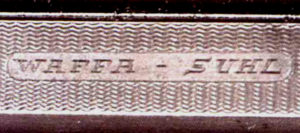 limited. Only one company would be allowed the make guns for the German police under strict supervision. Only the Simson Company applied and was given this right because they felt that it would give more workers in Suhl a future. For this they were attacked later by some of the Suhl gun makers and by the Nazis when they came to power.
limited. Only one company would be allowed the make guns for the German police under strict supervision. Only the Simson Company applied and was given this right because they felt that it would give more workers in Suhl a future. For this they were attacked later by some of the Suhl gun makers and by the Nazis when they came to power.
Before Hitler and the Nazis came to power in 1933 the propaganda against the Jews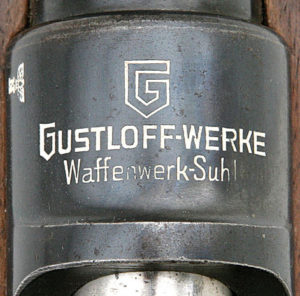 and the Simsons had already begun and the Simsons realized that the name of the company had to be changed to “Berlin- Suhler Waffen- und Fahrzeugwerke GmbH” using the letters BSW in adverting and promotion. But the people in Suhl said that it stood for “bis Simson wiederkommt”, “until Simson comes back”.
and the Simsons had already begun and the Simsons realized that the name of the company had to be changed to “Berlin- Suhler Waffen- und Fahrzeugwerke GmbH” using the letters BSW in adverting and promotion. But the people in Suhl said that it stood for “bis Simson wiederkommt”, “until Simson comes back”.
Soon thereafter they were forced to accept a few Nazi supporters to their Board of Directors as Trustees who then took over the company and named it “WAFFA”. But the court decided that the investment that was made by the new owners was not nearly sufficient for the take-over. “Gauleiter Saukel” a fanatic Nazi imprisoned the owners of Simson and would only release them from prison if they signed all their belongings over to the Nazi government. The Simsons signed, were released and immediately escaped to Switzerland. Fritz Saukel was hanged after the Nuernberg trials.
The Nazis changed the name of the factory to “Gustloff Werke”, after a man they 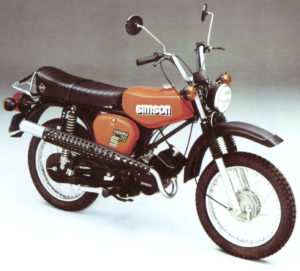 considered a martyr for the Nazi cause and declared it a “Nationalsozialistischer Master Organization” and under constant indoctrination all too many of the workers started to believed that the Simsons deserved their fate.
considered a martyr for the Nazi cause and declared it a “Nationalsozialistischer Master Organization” and under constant indoctrination all too many of the workers started to believed that the Simsons deserved their fate.
During World War II all Suhl gun makers made military guns or components for them and so did the Gustloff Works, including an anti- aircraft guns. You can find information about the arrival of American troops in Suhl in our Archive (83-T).
After Russian troops arrived 3 months later many of the best machines were crated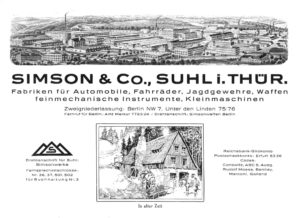 and sent toRussia as war reparations, but the making of hunting guns continued after several months, and many were also sent to Russia as war reparations. All the major companies were taken over by a Communist Government, including the Simson factory that produced not only guns but also motorcycles and motor scooters, still using the Simson name.
and sent toRussia as war reparations, but the making of hunting guns continued after several months, and many were also sent to Russia as war reparations. All the major companies were taken over by a Communist Government, including the Simson factory that produced not only guns but also motorcycles and motor scooters, still using the Simson name.
When the iron curtain came down and Germany was re-united the gun factories 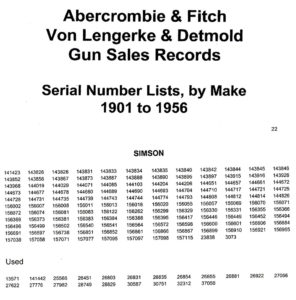 that had been taken over by the Communist Government came to a standstill until new owners could be found, but only the Merkel Company remained as an entity. Among those that wanted to take over were the remaining Simsons in America together with the Ruger Company, a successful gun maker in America, but the government agency chose a group of investors that only lasted a year. It then came into the hands of the Steyr Gun Company in Austria, then to the Heckler & Koch Company in Oberndorf where the closed Mauser Company had been located and finally to the present owners are Caracal International based in Abu Dhabi. The Merkel Company is the only major gun maker left in Suhl and also several small gun makers that are covered in this web-site.
that had been taken over by the Communist Government came to a standstill until new owners could be found, but only the Merkel Company remained as an entity. Among those that wanted to take over were the remaining Simsons in America together with the Ruger Company, a successful gun maker in America, but the government agency chose a group of investors that only lasted a year. It then came into the hands of the Steyr Gun Company in Austria, then to the Heckler & Koch Company in Oberndorf where the closed Mauser Company had been located and finally to the present owners are Caracal International based in Abu Dhabi. The Merkel Company is the only major gun maker left in Suhl and also several small gun makers that are covered in this web-site.
We decided to show all pages of a BSW catalog because it is in. English and covers all the different models that had been made in the Simson years, except for the much older hammer guns and the unique Simson-Jaeger guns that will be in the Archive that follow this paragraph. The catalog pages also describe the advantages Simson had because of their testing capability and technology that was needed for their production of motorcycles and automobiles. They stress the point, however, that the skill of the Suhl gun makers made the great variety of models and their high quality possible. You will find these catalog pages in our Archive (Nr.78-T).
all the different models that had been made in the Simson years, except for the much older hammer guns and the unique Simson-Jaeger guns that will be in the Archive that follow this paragraph. The catalog pages also describe the advantages Simson had because of their testing capability and technology that was needed for their production of motorcycles and automobiles. They stress the point, however, that the skill of the Suhl gun makers made the great variety of models and their high quality possible. You will find these catalog pages in our Archive (Nr.78-T).
It seems to us that not as many Simson guns were exported to America as some of the other major brands. The cause for this could be that Simson did not have an official importer here, and the list on the right of serial numbers of Simson guns sold by two importers in New Yorkseems to confirm this. Should you have a Simson gun with one of the listed serial numbers, you can get a written confirmation from Griffin & Howe. The other reason could be, that Simson attended all major shooting events in Europe and had good representation in all East European countries, as well as in Moscow.
You will find photos of the Simson Mansion, of shooting events, historical information, the unique Simson-Jaeger guns and a double rifle with the Kersten lock-up (Double Greener) in the Archive (Nr.42-PG)
The excellent book about Simson listed below was given to me by Axel Pantermühl, a very serious student of the history of Suhl and their gun makers. Although it is written in German, the many good photos alone make it a “must have” investment for those who are interested in the Simson story. You can find this book on the Internet:
Dr.Volker Schmuck
Simson – Eine Weltmarke im Wandel der Geschichte
296 Seiten mit 445 Farbabbildungen, 72 s/w Fotos,
Grafiken und Tabellen
Format 21 cm x 30 cm, gebunden,
Kunstlederdecke mit Goldprägung
49,90 € ISBN 3 – 9809481-9-6 Bestell-Nr.: 14169
We also have a scroll-down e-Book with a Simson catalog and other information in our Archive(nr. -ebook).
Gun Maker. Inventor, Businessman
Trade Mark: STENDA
Busines Locations: Suhl, Leipzig-Gohlis, Augsburg
Partners: Gustav Kersten, Alfred Loesche, Vierordt
Friedrich Stendebach must have been a restless fellow since he had numerous addresses in his 30 years as a gun maker, inventor and businessman. Not much is known about his personal life, but his unusual looking guns raise our interest and curiosity. Two 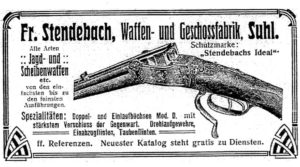 articles with good photos and patent drawings can best make you understand the thinking behind his patents and their practical value. The article about two unusual German Double Rifles was written by Fredrik Franzen and published in The Double Gun Journal Volume 12, Issue 4. <dgjournal@voyager.net>
articles with good photos and patent drawings can best make you understand the thinking behind his patents and their practical value. The article about two unusual German Double Rifles was written by Fredrik Franzen and published in The Double Gun Journal Volume 12, Issue 4. <dgjournal@voyager.net>
Excerpts from Stendebach Patents, two articles and gun photos are all in our Archive (Nr.32-PG)
The following complete history was written by Axel Eichendorff and found in a web-site.
Friedrich Stendebach’s last gun action patent, DRP # 229533 of 1907 had an “older predecessor” of this action. You have to go back to George Jeffries of Norwich British patent # 22 of 1862. Both the Jeffries’ and the Stendebach actions are effectively break-open actions turned sideways. On both actions the barrels are held to the breech face by the dovetail-shaped underlug going sideways into a corresponding cut in the action bar. In drawings this lug is curved on the Stendebach but wedge-shaped on the Jeffries.). To allow the barrels to move away from the breech face both actions have their hinges set over to the left beyond the centerline of the left barrel. The purpose of both inventors was to get away from the up-down stresses that is used to “break open” a conventional gun.
To read the complete history of the company and descriptions of their guns, go to the Archive.
Stiegele, Carl Anton
in Munich-GermanyThe business was founded in 1837 by Carl Anton Stiegele followed by Karl Stiegele Sr. and Karl Stiegele Jr. The first products were Zimmerstutzen (Parlor Rifles) and Bolzenbuechsen (Dart Guns) for indoor shooting. A new lock-up was developed and patented in 1867. This gave the company a substantial lift and a gun factory was built in 1868 at Knoebelstr. 13.The company exhibited at many Trade- and World Fairs and won numerous awards for the quality and accuracy of their rifles. Stiegele was appointed as gunmaker of many kings, princes and dukes.In 1904 the company built a factory for the production of bullets and loading equipment.Most production records were destroyed during the air raids in World War II and all guns and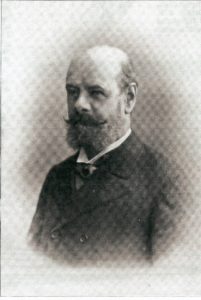 equipment were confiscated by American troops at the end of the war. Among them were 35 break-open hunting guns without forends. These forends were stored separately and 23 years later a hunter from Dayton, Ohio inquired about having a new forend made by the company. It was his luck, that the original forend was found, but nothing was ever heard of the other rifles without their forends.In the 1950s the Brandl family, who had worked in the company for three generations, took over the business and founded a subsidiary in the United States in 1954. In May of 1952 a shooting facility was opened in Hallenhofen and the Carl Stiegele hunting and shooting club was founded. An auction house was founded at Maximilian Street in 1985. Master Gunmaker Brandl supervised a modern gunshop that makes guns to order for customers all over the world. The company changed hands again a few years ago.Stiegele products and inventions: The type 16H bullet Carl Stiegele (1907)considered one of the best for target shooting with the 8.15 x 46 cartridge. The Stiegele Loading Mechanism for Zimmerstutzen was considered one of the best and copied by many.Just like many of today’s gun manufacturers have components made by other manufacturers, even in other countries, so did Stiegele in the past and today get components and services from other makers. Among the suppliers were the Gunmakers Cooperative in Suhl and in Ferlach, Springer in Vienna, Du Moulin in Belgium, as well as independant stock makers and engravers, some of them exclusively working for the Stiegele company. Raw actions for double guns and three barrel guns came from the forges in Suhl and in Ferlach. However, all guns got their most important final touch in the Stiegele shop.The classic Stiegle Zimmerstutzen with its patented loading device was always made completely in the Stiegele shops and for this the company had its own forge. These models were still made in house with modern machinery five years ago.Up to the 1940s Stiegele also had its own bullet production facility for all Feuerstutzen calibers and for 8mm and 9mm calibers.The company still exists under a new owner, Dr. Aschenbrenner, who is also an auctioneer who specializes in the sale of German hunting and sporting guns.This information was partly supplied by Tom Rowe, the author of three books about Schützen Rifles and by Victor Brandl, former owner of Stiegele, and is shared without any guarantee for its accuracy.You will find an article about a very unusual Stiegele Drilling made for the Emperor of Japan in our Archive.
equipment were confiscated by American troops at the end of the war. Among them were 35 break-open hunting guns without forends. These forends were stored separately and 23 years later a hunter from Dayton, Ohio inquired about having a new forend made by the company. It was his luck, that the original forend was found, but nothing was ever heard of the other rifles without their forends.In the 1950s the Brandl family, who had worked in the company for three generations, took over the business and founded a subsidiary in the United States in 1954. In May of 1952 a shooting facility was opened in Hallenhofen and the Carl Stiegele hunting and shooting club was founded. An auction house was founded at Maximilian Street in 1985. Master Gunmaker Brandl supervised a modern gunshop that makes guns to order for customers all over the world. The company changed hands again a few years ago.Stiegele products and inventions: The type 16H bullet Carl Stiegele (1907)considered one of the best for target shooting with the 8.15 x 46 cartridge. The Stiegele Loading Mechanism for Zimmerstutzen was considered one of the best and copied by many.Just like many of today’s gun manufacturers have components made by other manufacturers, even in other countries, so did Stiegele in the past and today get components and services from other makers. Among the suppliers were the Gunmakers Cooperative in Suhl and in Ferlach, Springer in Vienna, Du Moulin in Belgium, as well as independant stock makers and engravers, some of them exclusively working for the Stiegele company. Raw actions for double guns and three barrel guns came from the forges in Suhl and in Ferlach. However, all guns got their most important final touch in the Stiegele shop.The classic Stiegle Zimmerstutzen with its patented loading device was always made completely in the Stiegele shops and for this the company had its own forge. These models were still made in house with modern machinery five years ago.Up to the 1940s Stiegele also had its own bullet production facility for all Feuerstutzen calibers and for 8mm and 9mm calibers.The company still exists under a new owner, Dr. Aschenbrenner, who is also an auctioneer who specializes in the sale of German hunting and sporting guns.This information was partly supplied by Tom Rowe, the author of three books about Schützen Rifles and by Victor Brandl, former owner of Stiegele, and is shared without any guarantee for its accuracy.You will find an article about a very unusual Stiegele Drilling made for the Emperor of Japan in our Archive.
Steigleder, Ernst of Berlin & Suhl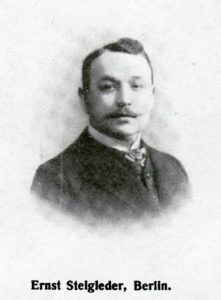
I wish to thank Fredrik Franzén and the Double Gun Journal for the following information which appeared in the Winter 2003 issue.
Ernst Steigleder was born on November 15, 1874 to Karl Friedrich and Anne Dorothea Steigleder of Suhl. Karl Friedrich was a barrel borer and engraver employed by the firm C. G. Haenel.
After Ernst finished school in 1888 he began a Merchant apprenticeship at J.P. Sauer & Sohne in Suhl. After the apprenticeship he opened a business in Berlin at Dorotheenstrasse 60 which was located near the German Parliament building -the Reichstag,Ministries and Embassies and the home of the German Emporer Kaiser Wilhelm II.
By 1899 he had purchased the gun Department of a Berlin Dealer H. Goetz & Co. at Friedrichstrasse 154. This firm was founded in 1865 and gave his firm an earlier founding date. From this time forward the firm was known as “Ernst Steigleder, formerly H. Goetz & Co.” He maintained a branch in Suhl at Judithstrasse 58 which was managed by his brother. In 1906 the name was changed to “Ernst Steigleder, Berlin-Suhl, formerly H. Goetz & Co. founded 1865”.
He exported firearms to Asia, the United States, South America, and the German colonies in Africa. 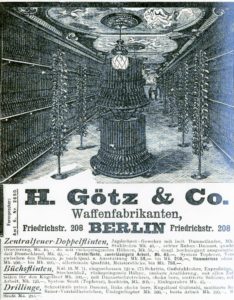 Counted amongst his customers was the Kaiser and his family, the King of Sweden and President Theodore Roosevelt. He named a model of a Tropen-Buesche the “Roosevelt” which was a bolt action carbine in cal. 9.3 x 74. He also equiped natural science expeditions to Asia, Africa and Greenland.
Counted amongst his customers was the Kaiser and his family, the King of Sweden and President Theodore Roosevelt. He named a model of a Tropen-Buesche the “Roosevelt” which was a bolt action carbine in cal. 9.3 x 74. He also equiped natural science expeditions to Asia, Africa and Greenland.
Ernst protected his technical inventions with German Patents (DRP) or as protected designs (DRGM) . Among his most noteworthy inventions was the “Steigleder lock-up” similar to the greener lock but with three barrel extensions. It was patented in Austria, Belgium and Germany in 1904.
Ernst passed away on October 16, 1929 and the business was continued by his widow Katharina, and she installed her son Wilhelm as manager. Katharina halted in house production at Herrenstrasse 18 in the spring of 1931. Beginning on May 8, 1931 the former Manager Theokar Kummer began producing firearms under both his and the Steigleder names at the above address. Gebrüder Merkel also built special order guns for the firm.
In 1941 Wilhelm Steigleder became the owner of the firm. On May 23, 1945 just three weeks after the end of the War Russian Troops set fire to the Company buildings in Berlin and all of the Company records were destroyed. Following the war gunmakers were not allowed to produce or sell guns in Berlin until 1952 when only air guns were permitted in the Western part of the City. In 1958, small bore sporting rifles could be sold to members of Rod and Gun Clubs. These rifles were required to be kept under lock and key at the club premises. Wilhelm Steigleder finally closed the business in 1972.
To go to the Steigleder Archive page and to read more about Ernst Steigleder and his products click Here.
Thieme & Schlegelmilch
Nimrod – Gewehr – Fabrik
Trade Mark “Nimrod”
Steinweg Nr.40 in Suhl, GermanyIn 1835 Caspar Schlegelmilch is recorded as the owner of a “Rohrhammer’, a barrel hammer work at Langebrücke 105 in Suhl.On May 4, 1850 Carl Adolph Thieme and Heinrich Nicolaus Schlegelmilch founded a gun factory at Steinweg 27. They always listed the trade mark “Nimrod” in addition to their names, 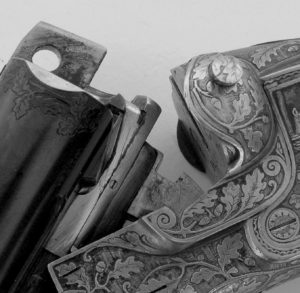 because there were quite a few gun makers with the same last name Schlegelmilch in Suhl.The name Nimrod was taken from the “Old Testament” and was also called “The great hunter of the Lord”.The Company made a great variety of hunting and sporting guns, including target rifles (Scheibenbüchsen), on actions of their own design. They were granted 8 Patents between 1877 and 1900.All Thieme & Schlegelmilch guns we have seen over the years were of the best quality and had features of their own design.The “Nimrod-Nasenverschluss” is one of their most important patented inventions, so called because of the two nose-shaped protrusions on the underside of the barrels that engaged recesses in the water table of
because there were quite a few gun makers with the same last name Schlegelmilch in Suhl.The name Nimrod was taken from the “Old Testament” and was also called “The great hunter of the Lord”.The Company made a great variety of hunting and sporting guns, including target rifles (Scheibenbüchsen), on actions of their own design. They were granted 8 Patents between 1877 and 1900.All Thieme & Schlegelmilch guns we have seen over the years were of the best quality and had features of their own design.The “Nimrod-Nasenverschluss” is one of their most important patented inventions, so called because of the two nose-shaped protrusions on the underside of the barrels that engaged recesses in the water table of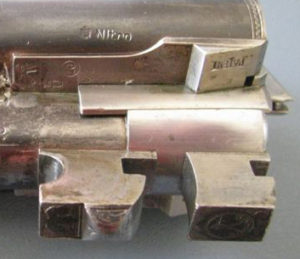 the action and act like recoil shoulders to prevent loosening of the barrels from the action. They serve as additional fasteners besides the traditional Greener bolt on top and the Purdey type bites on the underside and also prevented side to side loosening of the barrels.The photo of the patented Thieme & Schlegelmilch Box Lock on the right shows its unusual design with cover plates that resemble those of side lock guns.The Nimrod Side Locks of their very own patented design has an L-shaped sear that engages a stud on the hammer fairly high up and away from its pivot pin, allowing a very good and reliable trigger pull. A hole above the hammer is for the spindle of the safety lever that blocks the hammers from
the action and act like recoil shoulders to prevent loosening of the barrels from the action. They serve as additional fasteners besides the traditional Greener bolt on top and the Purdey type bites on the underside and also prevented side to side loosening of the barrels.The photo of the patented Thieme & Schlegelmilch Box Lock on the right shows its unusual design with cover plates that resemble those of side lock guns.The Nimrod Side Locks of their very own patented design has an L-shaped sear that engages a stud on the hammer fairly high up and away from its pivot pin, allowing a very good and reliable trigger pull. A hole above the hammer is for the spindle of the safety lever that blocks the hammers from 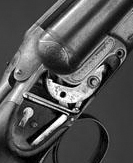 falling. This is one of the most reliable safeties that were used not only on their side lock guns but also on their box lock actions. Both are very good design features, and the gun maker Retz and his son in Suhl still make guns today with both Nimrod inventions. The Krieghoff Company also uses the Thieme & Schlegelmilch sidelock design on their Essencia side lock shotguns. Both companies have listings and information in Section 5.The base of the Thieme & Schlegelmilch Scope Mount shown on the right is an integral part of the right barrel. A scope could be mounted without obstructing the view
falling. This is one of the most reliable safeties that were used not only on their side lock guns but also on their box lock actions. Both are very good design features, and the gun maker Retz and his son in Suhl still make guns today with both Nimrod inventions. The Krieghoff Company also uses the Thieme & Schlegelmilch sidelock design on their Essencia side lock shotguns. Both companies have listings and information in Section 5.The base of the Thieme & Schlegelmilch Scope Mount shown on the right is an integral part of the right barrel. A scope could be mounted without obstructing the view 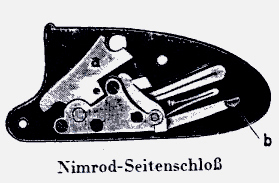 with open sights or with offset rings high enough over the center of the top rib.The company also developed and produced several black powder rifle cartidges and sold loaded ammunition and brass cases.Thieme & Schlegelmilch were one of the founders of the Rhömer Company in Suhl that produced gun components for the various gun makers in Suhl and vicinity. After Ernst Schlegelmilch passed away in 1934, the owner of the Christoph Funk Company bought Thieme &
with open sights or with offset rings high enough over the center of the top rib.The company also developed and produced several black powder rifle cartidges and sold loaded ammunition and brass cases.Thieme & Schlegelmilch were one of the founders of the Rhömer Company in Suhl that produced gun components for the various gun makers in Suhl and vicinity. After Ernst Schlegelmilch passed away in 1934, the owner of the Christoph Funk Company bought Thieme & 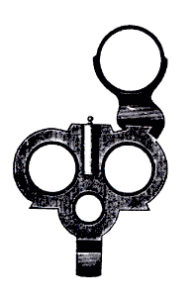 Schlegelmilch for his son Alfred.who managed it until 1937 under the name Nimrod- Gewehrfabrik Thieme & Schlegelmilch. In 1936 the company moved to a new location at Nr.18 Gothaer Strasse.The now very small company did not survive World War II.Much of the information can be found in the book “Suhl-Heimat der Büchsenmacher” by Dr. Hans-Jürgen Fritze. An articles from “Der Waffenschmied”, the Journal of the German Gun Collectors Association, about a Drilling that was presented to a German Submarine Commander, and pages from Julia Auctions Catalogs www.jamesdjulia.com, and photos and an article about a very unusual double rifle by Fredrik Franzen in the Double Gun Journal <dgjournal@voyager.net> can all be found in our Archive (Nr.29-PG).For an interesting story about a historic Thieme & Schlegelmilch gun, go to our Archive (Nr.2-T).
Schlegelmilch for his son Alfred.who managed it until 1937 under the name Nimrod- Gewehrfabrik Thieme & Schlegelmilch. In 1936 the company moved to a new location at Nr.18 Gothaer Strasse.The now very small company did not survive World War II.Much of the information can be found in the book “Suhl-Heimat der Büchsenmacher” by Dr. Hans-Jürgen Fritze. An articles from “Der Waffenschmied”, the Journal of the German Gun Collectors Association, about a Drilling that was presented to a German Submarine Commander, and pages from Julia Auctions Catalogs www.jamesdjulia.com, and photos and an article about a very unusual double rifle by Fredrik Franzen in the Double Gun Journal <dgjournal@voyager.net> can all be found in our Archive (Nr.29-PG).For an interesting story about a historic Thieme & Schlegelmilch gun, go to our Archive (Nr.2-T).


